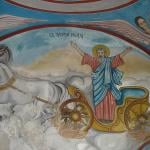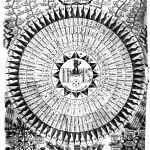A reader writes:
I was wondering what your take is / if you have written anything on the topics of the “Synoptic Problem” (I know you’ve written about the theory of a community writing the Gospel of John) and/or the issues surrounding the use of the majority versus minority texts of Greek manuscripts for establishing what is the “authentic” Bible.
The closest I’ve come to writing about the synoptic problem was when I co-authored with Scott Hahn a study of Matthew for Catholic Scripture Study. Here is the relevant portion:
Authorship and Date
One curious paradox about the canonical gospels is that none of them are signed, whereas many of the spurious gospels (such as the so-called Gospel of Nicodemus) make explicit claims to authorship by the famous person in the title. The title “Kata Matthaion” (“According to Matthew”) was given to the gospel by the early Church after its composition. It was not part of the original text. Modern readers get nervous when they hear this and assume this means the Church can have no idea whether the canonical gospels were actually written by their attributed authors of Matthew, Mark, Luke and John. In reality, however, the reason the Church did not need the signatures on the gospels was because the whole community preserved the memory of who was behind each of the gospels. In the same way, the community preserved the awareness that, whatever the name on the label said, the alleged gospel of Nicodemus was no more genuine than a forged biography of Howard Hughes. The verification of the gospel of Matthew, as of all the canonical gospels, was accomplished, not by reading a signature, but by the unanimous testimony of the entire Christian community contemporary with and subsequent to the apostles that it preserved the testimony of the apostle Matthew. And the attribution of this gospel to the apostle Matthew is, make no mistake, absolutely unanimous in the ancient Church.
This attribution, in itself, is remarkable precisely because Matthew like, say, Bartholomew or Nathanael, is not particularly a notable character in the gospel stories themselves. Very little is known of him except that he also went by the name “Levi” (Mark 2:14; Luke 5:27) and that he once worked as a tax collector (Matthew 9:9) before he was called by Jesus. From this, we can speculate that he may have been a scribe as well since many scribes used their skills in literacy in order to do the work required of a functionary such as tax collector/publican. We know he once held a feast for Jesus (Luke 5:29) and became one of his apostles (Matthew 10:2-3). Finally, we know he was present in the Upper Room at Pentecost (Acts 1:13). Beyond this, he is utterly obscure. It is therefore inexplicable why the Church would fix on him as the author of this gospel (particularly given the unpopularity of his profession) unless he is indeed the author.
However, since the rise of the historical-critical method of biblical criticism, it has become a commonplace to fudge the apostolic authorship of Matthew by saying that the ancient mind had a different concept of authorship than we moderns do. Authorship, according to this theory, was more “fluid” so that a “school” of a particular writer could produce works which could be attributed to the writer himself. Thus, according to this theory, the pastoral epistles of 1 and 2 Timothy are allegedly the work of a “deutero-Pauline” author, not of Paul himself, and they speak in Pauline words, not in Paul’s actual words. Likewise, it is asserted, Matthew is supposed to be the work, not of Matthew, but of a “Matthean community” which attributed their work to him. The difficulty with this theory is that, in the second century, we do know of one presbyter who, in fact, composed a document and claimed apostolic authorship for it. He was excommunicated for doing so (see “Pseudonymity and Canonicity” by E. Earle Ellis in Worship, Theology and Ministry in the Early Church edited by Wilkins and Paige [Sheffield, UK: JSOT Press. 1992], pp. 212-224). This tells against the idea that the concept of apostolic authorship was all that fluid.
Further, Dei Verbum, the “Dogmatic Constitution on Divine Revelation” from Vatican II, specifically states that the gospels were written by apostles and apostolic men. In our opinion, this teaching makes most sense in light of the traditional opinion that two of the evangelists were apostles (Matthew and John) and two were apostolic men (Mark, who traveled as Peter’s companion, and Luke, who traveled as Paul’s). Thus, the Magisterium echoes an unbroken tradition that goes back to the Fathers of the early second century.
Matthew is the first of the three synoptic gospels (the other two being Mark and Luke). “Synoptic” means “seen with one eye” and the term refers to the fact that the three gospels have long been noted for their remarkable similarities, not only with respect to the events reported but even in the very language which is used to report them. Many modern biblical critics argue on the basis of this similarity that Matthew used Mark and another document (called “Q” from “Quelle”, the German word for “source”) in order to compose his gospel. The difficulty with this theory is that this means Matthew (an eyewitness) used the writings of a non-eyewitness to write his gospel. Some argue that this means that Matthew recognized in Mark’s gospel the primacy of Peter (since Mark is recording Peter’s preaching). But this overlooks the repeated claim by numerous patristic voices (e.g. Papias, Irenaeus, Origen, Eusebius and Jerome) that Matthew was the first to compose his gospel and did so in Hebrew (or its closely related cousin Aramaic) and it was then translated into Greek later on, whereas all the evidence we have for Mark indicates it was composed in Greek. Textual analysis confirms that there is indeed an underlying Hebrew basis for Matthew’s collection of sayings (many of which contain puns only intelligible in Hebrew). Jerome, indeed, tells us he has seen a Hebrew text of Matthew in the library at Caesarea. And even early heretical sects preserved the gospel of Matthew in Hebrew under the title “According to the Hebrews”.
Other scholars, taking for granted the assumption that Matthew depends on Mark, argue that Matthew was therefore written after—in fact, well after—the destruction of Jerusalem in 70 AD. Generally, the rationale for this argument is that Matthew records a clear prophecy from Jesus in Matthew 24 concerning the coming destruction of Jerusalem. The assumption here is that true prophecy does not occur so Matthew must be retrojecting a “prophecy” into the mouth of Jesus after the event. The problem with this theory is that neither Matthew nor any other gospel clearly describes the destruction of the Temple as an event that has occurred. But if they could have, they would have. Why? Because the entire thrust of the New Testament (mark that term!) is that the Old Testament has passed away and the new has come. Thus there are endless arguments to the effect that circumcision no longer is required, the levitical priesthood is no longer necessary, animal sacrifices must give way to the sacrifice of Christ. None of the gospel writers say, “See! We told you!” apparently because none of them are writing after the destruction of the Temple. And Matthew, in particular, takes great pains to point out occasion after occasion where prophecy is fulfilled. His mysterious silence in this case is best explained by the assumption that, when he composed his gospel, the prophecy was not yet fulfilled. And this assumption gains greater force when we note that other documents we know to have been written after the destruction of the Temple do indeed refer back to that event as Exhibit A in their case against the Judaizers who demand conformity to the levitical system in order to be a Christian. (See, for instance, J.A.T. Robinson’s Redating the New Testament, as well as the numerous).
In summary then, the gospel of Matthew was, according to the unanimous testimony of the Fathers, written by the apostle Matthew in Hebrew Aramaic sometime between 50 and 70 AD and translated into Greek by some unknown person(s) shortly thereafter. The apostolic origin of this gospel has been repeatedly confirmed by the Magisterium, notably in the document Dei Verbum from the Second Vatican Council. We see no compelling reason to doubt the traditional belief that Matthew is the author of his gospel.
I recognize that this is (currently) a minority view, but there it is. For further info on the problem with Q, you should check this out.
I’m not hyper-committed either to the two source theory, nor to rejection of same. I have no problem with the possibility that Matthew and Luke might have relied on the testimony of Peter, in part, since I have no problem with Petrine primacy. However, I’m not convinced it’s a slam dunk either. Whatever happened in the composition of the gospels, God’s was the principal author.
As to quibbles about minority vs. majority MSS, I leave that to scholars and the magisterium, of which (thank God) I am not a member of the ranks.











